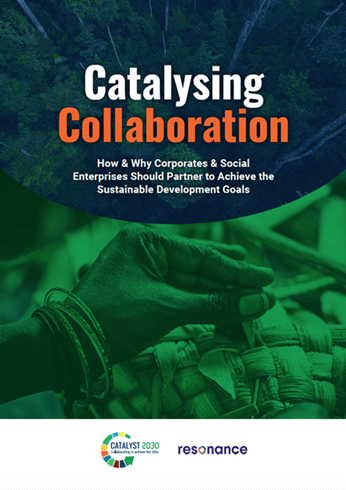Format
Downloadable/printable .pdf document
Launched
1 July 2021
Author/s
Resonance and the Catalyst 2030 Private Sector Working Group
Overview
This report explores how and why large companies partner with social enterprises to expand opportunity in emerging markets and solve complex challenges. Through interviews with a dynamic group of companies, social entrepreneurs, impact investors, and intermediary partners, Resonance and Catalyst 2030 explored how companies are building social enterprises into their value chains; sponsoring social entrepreneurs to scale impact; and taking ambitious steps to create more supportive innovation ecosystems.
Executive Summary
The United Nations’ 17 Sustainable Development Goals (SDGs) lay out a framework for global action to create a better, more equitable, more sustainable future by 2030. Success will demand innovative, cross-sector action at scale. Importantly, forging the path toward a brighter future is not just the work of government and civil society: The private sector must be an engaged leader and partner.
Strategic global companies are stepping up, making ambitious pledges for the SDGs and integrating sustainability investments into core business strategy. To advance this work, companies are, increasingly, on the hunt for new partners—and new ways of driving impact. Here, we argue that social enterprises are a vital part of the equation.
Social entrepreneurs are designing, testing, and growing innovative new business models that can help companies solve pressing sustainability challenges; reach underserved customer populations; and advance more ethical, more resilient supply chains. In this report, we draw on desk research, interviews, and real-world case studies to help companies better understand the value social enterprises can bring to the table, the ways in which companies and social enterprises collaborate for impact, and how to more effectively partner for success.
Companies and social enterprises can come together in any number of ways. In the pages that follow, we look at a range of collaboration models—including joint programs, industry alliances, incubation, and acquisition—with a particular focus on two primary types:
- Value chain partnerships, with social enterprises acting as responsible suppliers, last-mile distributors, or innovative business-to-business (B2B) service providers.
- Strategic sponsorship, through which the company extends funding, mentorship, or other in-kind support to continue, scale, or evolve social enterprises activities.
In the final section, we offer recommendations to help companies improve collaboration strategy and tactics at every stage of the partnership lifecycle. These cover:
- Pre-Partnership: Getting clear on objectives and focusing your collaboration strategy; choosing the right collaboration model; informing your strategy through pre-competitive conversations; and appointing a designated partnership point person.
- Partnership Design: Aligning success to core business objectives; building a “true partnership;” ensuring internal buy-in; communicating effectively; and offering patience and flexibility.
- Partnership Implementation and Evolution: Working as a team; creating a contingency plan; establishing regular, open communication channels; collecting data, stories, and insights on business and social impact; using your influence to drive industry change; and evolving your collaboration strategy toward an ecosystem approach.
Our Calls to Action
We believe the potential is significant; yet, today, that promise is largely untapped.
- We call on companies to venture and test new opportunities to partner for impact, and to deepen existing collaboration. In particular, we urge corporates to look for ways to strategically invest in relevant innovation ecosystems to create better enabling conditions for systems change.
- We call on all stakeholders—companies, social enterprises, social enterprise intermediaries, and finance partners—to share their collaboration impact data and examples and to strategically combine networks to inspire and streamline future company-social enterprise partnership efforts.
Catalyst 2030 and Resonance are excited to help drive this conversation, to illuminate the possibilities and spark bold cross-sector collaboration for the future we need and want.

